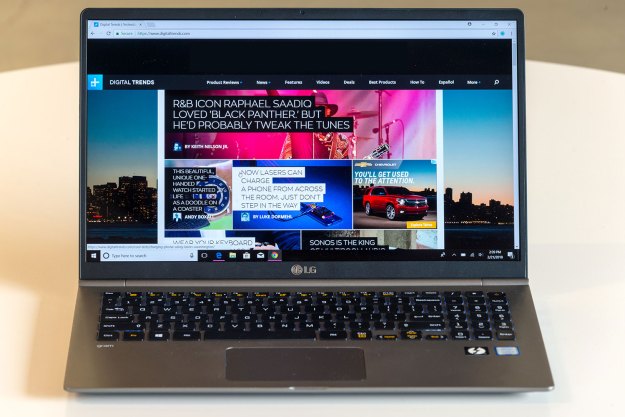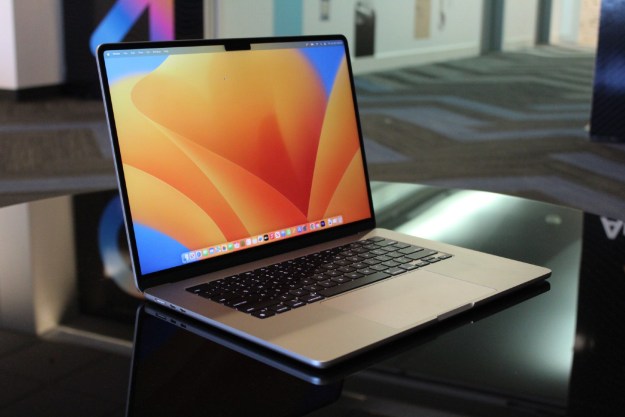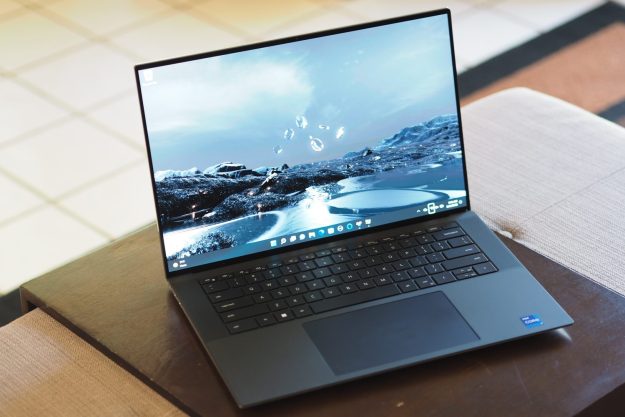
“The LG Gram is insanely light, but its price is a bit nuts.”
- Extremely light
- Includes Thunderbolt 3
- Fast, zippy processing
- Thin bezels
- Good battery life
- A bit overpriced
- No 4K display or GPU, despite high price
- Lots of flex in the panels
- Display is only average
When you think of LG, you probably don’t think of laptops. The company has kept its efforts in the space relatively conservative, limited to just a single line of computers: Gram. LG has now updated the entire line to 8th-gen Intel processors, as well as more prominently featuring ‘Gram’ in its branding.
With configurations ranging from the $1,100 13-inch Core i5 model up to the $1,550 Core i7 15-inch model, there’s a Gram for a wide variety of budgets. Our review unit was stuffed with two 500GB SSDs and 16GB of RAM, coming to a total of $2,000. Throughout all the models, you’re getting a surprisingly lightweight design, complete with the latest generation of Intel processors. Yet due to some choices LG made with the Gram, these aren’t the most versatile laptops out there.
The lightest 15-inch laptop you’ll ever use
LG wants you to see its
It was a good decision to brand it differently — we just wish LG went a step further with making the Gram feel distinctive. It has a conventional look, simple lines and edges, a dark shade of silver like the MacBook Pro’s “space gray” color scheme, and a slightly textured “nano-carbon magnesium full metal alloy body.” To translate, the chassis has a unibody metal look and feel, but flexes like plastic with a little pressure.
LG claims that the 15-inch Gram meets U.S. Military Standard 810G certification, but this much bend in the lid makes us a little nervous, especially when it’s housing a $2,000 computer. We don’t get the impression that it was shoddily constructed, just that LG cut corners with the materials being used here. Compared to a MacBook Pro, Surface Book 2, or Dell XPS 15, the Gram feels far less luxurious.
It’s not all bad. We like the hinge on the Gram 15, which is loose enough to be able to open it with just one finger. The bezels around the display are small, making them some of the narrowest we’ve seen on a laptop outside of the Dell XPS 13. That gives the Gram an updated, modern style that compensates for some of the more modest design choices. The bezels shrink down the footprint of the laptop, making the 15.6-inch display feel rather compact. This is a very portable PC, which is another point in LG’s favor.
It might not be as light as a gram, but it’s the lightest 15-inch laptop we’ve ever used.
At just 2.4 pounds, it might not be as light as a gram, but it’s the lightest 15-inch laptop we’ve ever used. For reference, the 15-inch MacBook Pro weighs just over 4 pounds, and the 15-inch Surface Book 2 is 4.2 pounds. The only 15-inch laptop that comes even close is the 15-inch Samsung Notebook 9, which comes in at 2.76 pounds. That’s an impressive achievement, and one that makes carrying around a 15-inch laptop much more manageable.
The LG Gram comes with a healthy platter of port options. What you get is three USB-A ports, a Thunderbolt 3 USB-C, one HDMI, a microSD slot, and a Kensington lock. You’ve got something for everyone.
We might have preferred one more USB-C port in exchange for one of the USB-A ports, but most people will be happy with what they have here. We also wished that LG offered
A useful but cramped keyboard
Keyboards and touchpads are vital parts of the laptop form factor, and fortunately, LG didn’t leave them as an afterthought. Both are better than your average Windows laptop, although maybe not for something this expensive. The keyboard is softer than we prefer, without enough clickiness for our taste. Fortunately, it’s rather quiet, which some people will really like. Yet compared to machines like the XPS 15 and Surface Book 15, the LG Gram feels imprecise. In addition, LG has decided to squeeze in a numpad. While that’ll be a feature for some, it makes the keys feel a bit too cramped. The backlighting is even, though we wish there were more than just two brightness settings.
We’re always searching for a touchpads that don’t suck — and LG has done a decent job this time around. The glass surface is smooth and the tracking feels accurate. The click isn’t as loud and stiff as the Samsung Notebook 9 Pen, but it’s also not as comfortable as something like the Dell XPS 15, Surface Book 2, or MacBook Pro 15. It has Windows Precision drivers to support gestures and didn’t have problems registering motions like two-finger clicks or swipes. You’ll get used to it eventually, but it’s certainly not one of the best out there.
One thing to note is that the touchpad feels a bit too small for this laptop. It’s almost as if LG carried over the same exact touchpad from the 13-inch version, rather than utilizing the extra space more efficiently.
As a bit of a surprise, the LG Gram has a 1080p webcam on the front of the laptop, which is better than the 720p camera on the Dell XPS 15 or MacBook Pro 15. It’ll be sure to please businesspeople who often find themselves on conference calls while on the road.
The Gram’s display isn’t anything special
LG only offers a 1080p screen for the Gram 15, which is disappointing given its $2,000 price tag. The XPS 15 delivers 4K at $1,750, while both Apple’s MacBook Pro and Microsoft’s Surface Book offer higher-resolution displays in every configuration. HP even offers the Envy 15t with a
The display looks fine in normal use, but most of the Gram 15’s competitors look incredible.
Image quality wasn’t superior, either. Contrast was good, but not great — as was brightness, which maxed out at 289 nits. The screen showed 76 percent of the Adobe RGB color space, taking a backseat to
The speakers fare better. They’re plenty loud at full volume and don’t distort, even though they’re down-firing. You still don’t hear much bass out of them, but for laptop speakers, they get the job done.
So much speed, so much space
The LG Gram offers several different 8th-gen processor options, but our review unit came with the Intel Core i7-8550U, which is a high-end CPU for thin
The Gram handles its thermal cooling well. Even during the most intense testing, it was never uncomfortably hot, and its fans remained surprisingly quiet throughout.
Storage is where LG has doubled down. Rather than offering
As for the speed of the storage, it’s average. LG went with a SATA connection instead of PCIe, so speeds don’t come close to the Surface Book 2 or Dell XPS 15. Reading and writing files wasn’t noticeably slow, but LG clearly went with quantity over quality here. That’s going to be ideal for some people, and frustrating for others.
No dGPU? Really?
This where we really started to question LG’s decisions for the Gram. Rather than putting a discrete GPU in the Gram, they opted to leave the graphics to just Intel’s integrated capabilities. Every other 15-inch laptop that compares to this one has at least an option for discrete graphics, but LG hasn’t even made one available. Obviously, this isn’t meant to be a gaming laptop, but it’s nice to have the option.
As you can see from the 3DMark score, the Gram can’t compare to other 15-inch
The 72Wh battery is a whole lot of juice
LG claims that the Gram gets 16.5 hours of battery life. We’ve tested enough
In our video loop test we saw around 14 hours and 40 minutes of life, while it ran for 4 hours in our intensive Basemark web browsing test. While it’s not the best we’ve tested, it does do better than
When you consider the battery life and the light weight, it adds up to a very portable laptop, especially for its large size.
Warranty
As has become standard for
The LG Gram would be a great laptop for business people looking to take their work on the road. It’s the lightest 15-inch laptop we’ve ever seen — and that’s quite an accomplishment. However, without a higher resolution display and a discrete GPU, it falls short of offering enough value for us to recommend it to the average person looking for a laptop.
Any alternatives?
The most important alternative to consider is the Dell XPS 15. Even though it’s nearly a year old at this point, the Core i7-7700HQ processor holds up great, even compared to 8th-gen CPUs like the LG Gram. More importantly, it offers a
If you expand your search to 15-inch 2-in-1s, you’ll run across some even stiffer competition. A good example is the excellent Lenovo Yoga 720, which delivers a TB of faster, PCIe storage, a higher resolution display, and even a dedicated GPU, for just $1,450.
Other strong alternatives are the 15-inch Surface Book 2 and MacBook Pro. Both are more expensive with similar hardware but perform better across the board.
How long will it last?
The LG Gram should last you a solid few years, especially if its durability certification holds true. The CPU is still fresh, and the
Should I buy it?
No. If you’re looking specifically for a super-portable 15-inch work laptop that you can take on the road, it could be worth a look. But for the most part, other 15-inch
Editors' Recommendations
- The best 17-inch laptop deals from HP, LG, Razer, and more
- Best Buy deals: Save on laptops, TVs, appliances, and more
- This Acer OLED laptop (almost) beats the MacBook Air 15 — and it’s cheaper
- The Dell XPS 15 has one major advantage over the MacBook Pro
- Apple’s serious miscalculation with the 15-inch MacBook Air







